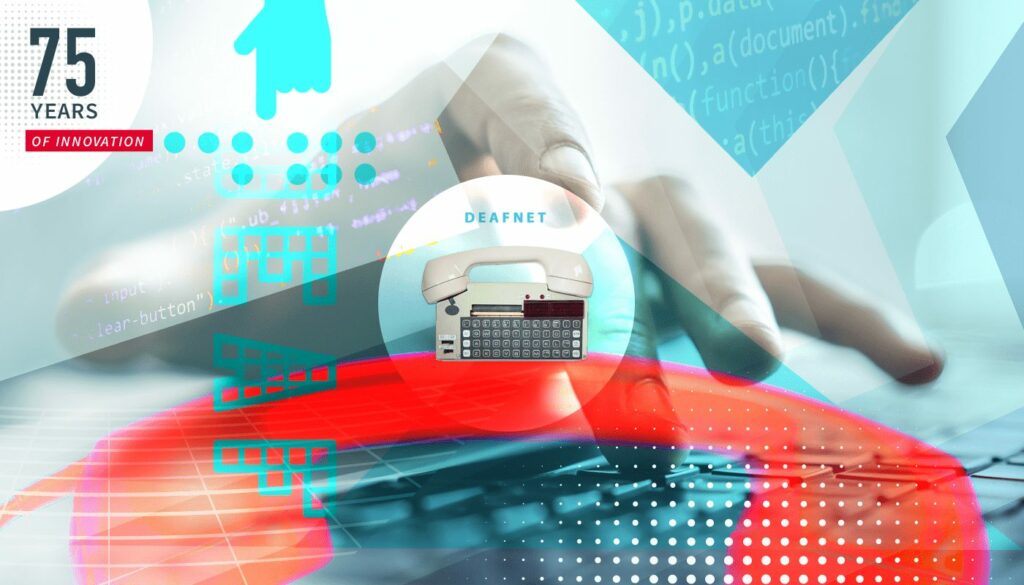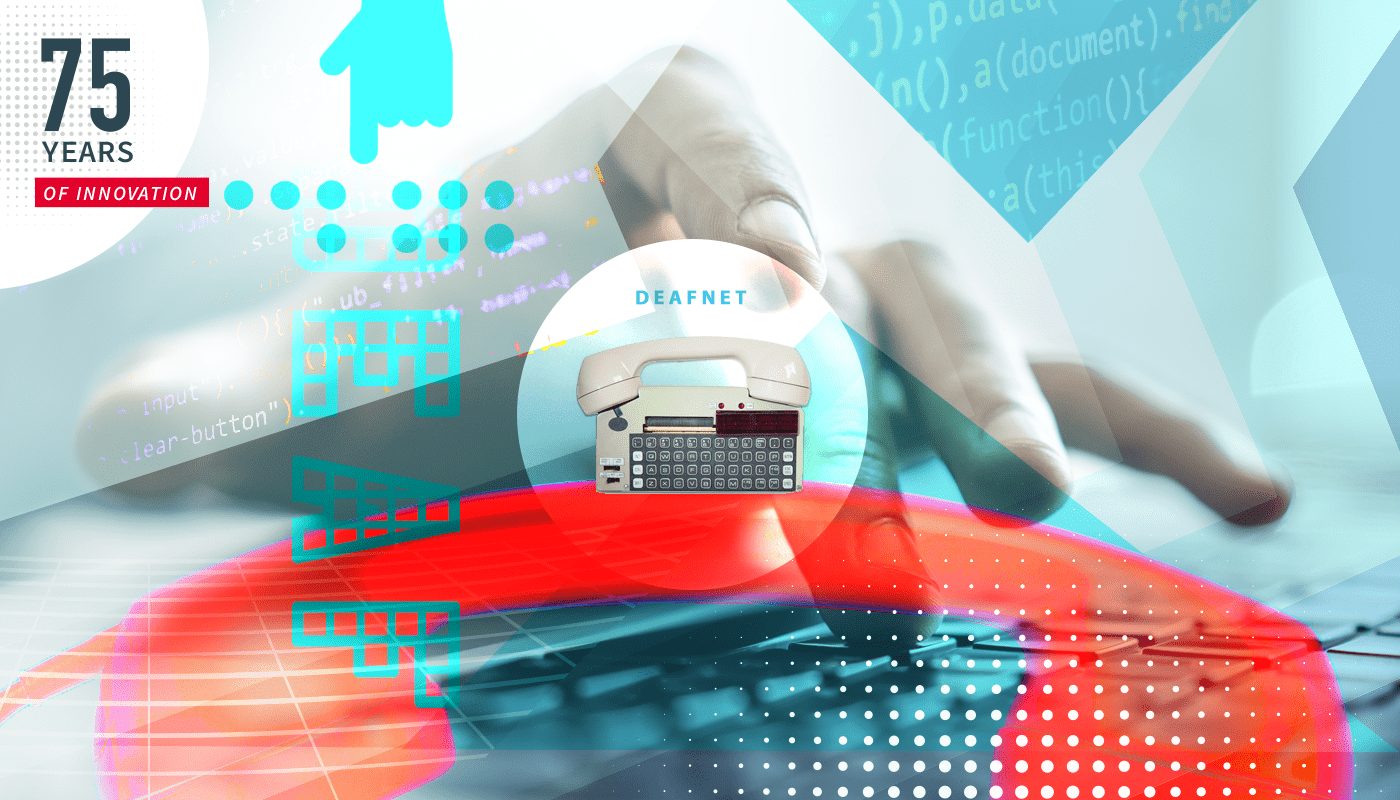The 75 Years of Innovation series highlights the groundbreaking innovations spanning from SRI’s founding in 1946 to today. Each week, SRI will release an innovation, leading up to its 75th anniversary in November 2021.

A computer-based communications network accessed by either a telecommunications device for the deaf (TDDs) or standard computer terminals
The DEAFNET communication network for people with hearing loss
If anything can be said about humans, it is that we value communication. As technology has become a part of our lives, we have used it to communicate with family, friends and the broader world of business. From Morse code to the telephone to Zoom, communication is crucial to our well-being, health and wealth.
But imagine if one of the most important communication tools, the telephone, was useless to you? People with hearing loss have challenges with communication devices like the telephone, which were designed for those with full hearing capability. It is possible to read messages, however. Email, for example, has been a transformative force in communication and is now ubiquitous. But this wasn’t always so.
DEAFNET was an SRI-led project to explore and develop a computer-based telecommunications system for people with hearing loss that could be used with a telephone. It was a revolution in communication that also shaped today’s email-based communication.
Leveling the communication playing field
Back in the 1970s and 80s, if a person who was hard of hearing wanted to use a telephone, they had to use a special device connected to the phone, such as a teletypewriter (TTY). This allowed those who were hard of hearing to type messages to each other in real-time over the phone line. The TTY was another innovation of SRI International, co-invented by SRI physicist Robert H. Weitbrecht.
In the late 1970s, SRI International, the National Association of the Deaf and the Department of Health, Education, and Welfare (HEW) collaborated on a project that would establish a computer-based telecommunications network for people with hearing loss. This new computer-based system, known as DEAFNET, was more versatile than the telephone-based TTY service.
For this project to work, the SRI team had to ensure that the 20 largest U.S. cities had the proper infrastructure to establish DEAFNET facilities. This included giving the cities information and technical assistance, as well as encouragement and confidence to make DEAFNET work for their residents with hearing loss. In other words, this project was about much more than mere technology.
To put this project into context, in the late 1970s, personal computers were still very much emerging. Commercial email for the general populace was in its infancy. SRI had a dream of using this nascent form of electronic communication to open up the world of instant communication for those with hearing loss.
At that time, people who had full hearing ability had an advantage over those who did not by being able to use the ubiquitous communication vehicle, the telephone. Making real-time communication available for those with hearing loss would open up access to friends and family as well as work, government services, and so on. Such a system could be used to level the communication playing field for all.
What was DEAFNET?
The email software underpinning the DEAFNET project was a modified version of that used by the ARPANET project, which SRI helped develop.
DEAFNET was designed to send and receive email-like messages via a computer terminal attached to a telephone. Keeping this as close to a telephone model as possible meant that the system was familiar and could use the existing network infrastructure. But computing at that time was an expensive business. One of the DEAFNET project goals was to make it affordable and accessible for all who would benefit from it. To establish DEAFNET, SRI had to encourage local communities to take on the task of expanding DEAFNET into their jurisdiction. To help with this, SRI created a prototype package that could be replicated by local communities. By September 1979, the network and email coverage expanded to include mail hosts in Boston.
DEAFNET was for people with hearing loss, so it seemed appropriate that they took ownership of the projects in the local community. These users were active at every stage of the project, teaching new members to use the system to evaluations. Those with hearing loss made up a majority of the project’s board of directors.
One of the hopes for DEAFNET was that the system, being designed for one group of people, could prove a useful technology for other groups too. After all, communication is universal, and DEAFNET was a demonstration of how real-time, fast, cost-effective text-based communication could work.
Under HEW sponsorship, SRI began a dissemination phase, assembling systems for another nine metropolitan areas around the country. These areas were New York, Newark, Chicago, Oakland, Los Angeles, Dallas, Minneapolis, St Louis and Washington D.C. While this phase ended up being less successful than the demonstration project, DEAFNET created awareness within the community of emerging new technologies.
Designing good technology means designing for all
Email and mobile messaging are arguably the modern-day equivalents of DEAFNET. Communication is a fundamental human need and right. Just because a person has hearing loss does not mean they do not need the same level of connectivity to other humans and services. While the DEAFNET project explored this need and identified ways of building cost-effective, usable communication systems for people with hearing loss, it contributed to the development of email and text messaging that today are used by everyone; today, there are over 4 billion active email accounts. In this way, SRI has demonstrated that specialized applications often have universal ramifications.
Resources
SRI Journal, February 1983: https://smecc.org/deafnet.htm
CDC, Summary Health Statistics for U.S. Adults: National Health Interview Survey, 2012: https://www.cdc.gov/nchs/data/series/sr_10/sr10_260.pdf
SRI International, The Dish, ARPANET: https://medium.com/dish/75-years-of-innovation-arpanet-4c23a0162d25



